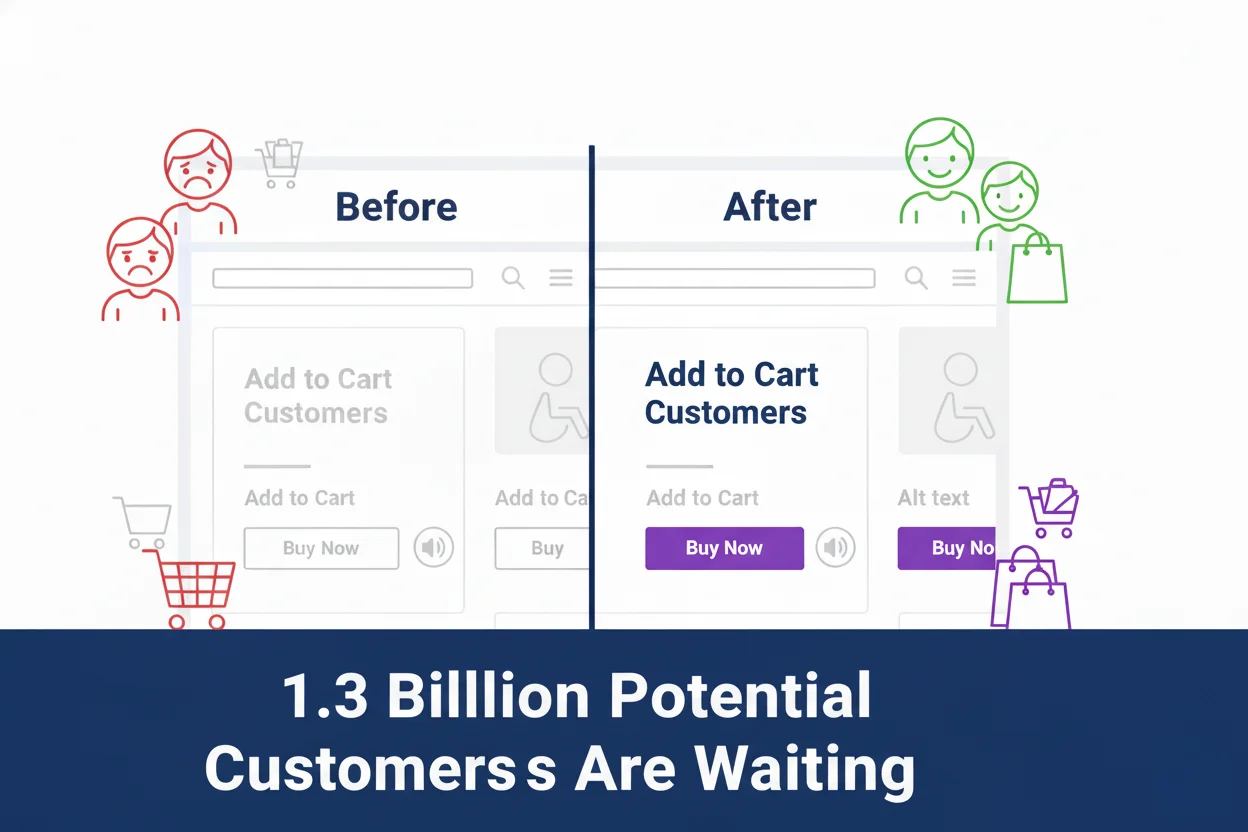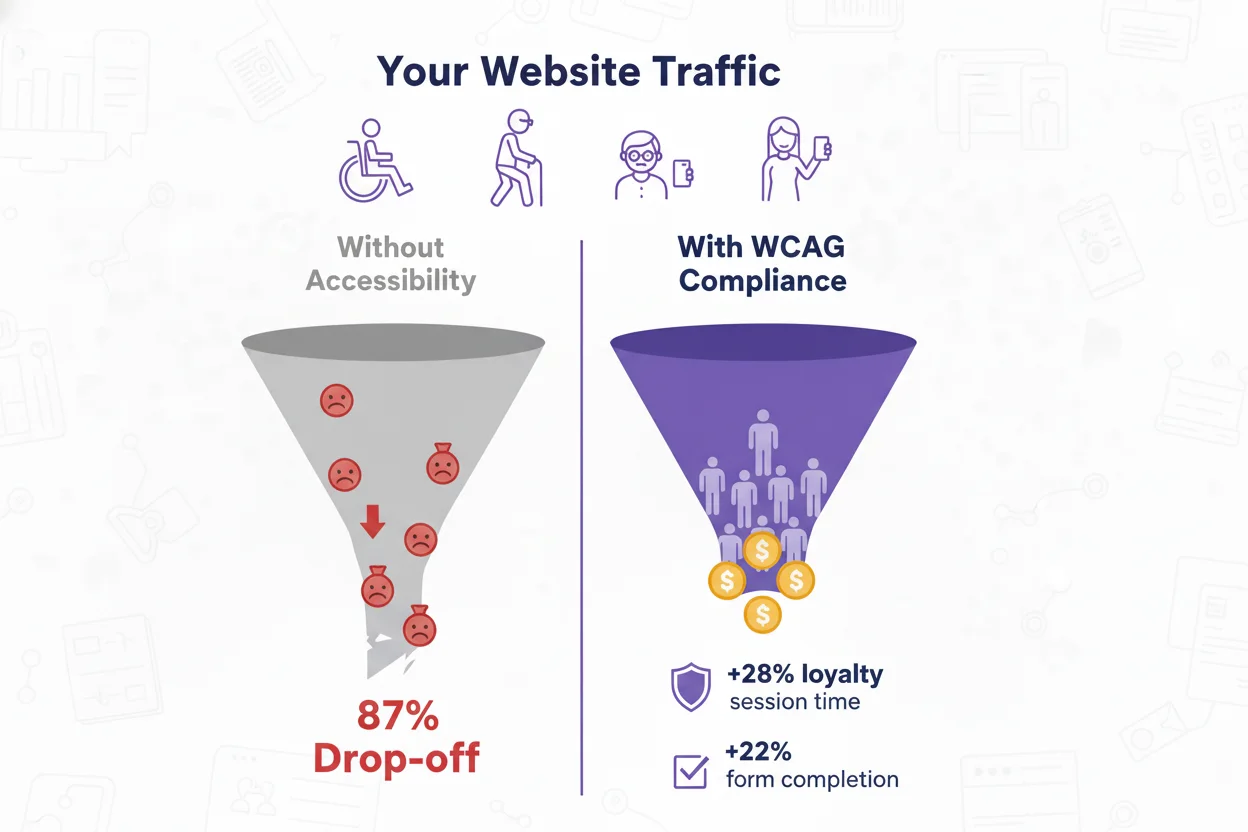87% of brands fail basic accessibility. Learn how WCAG-compliant branding attracts MORE customers and protects you legally.
Introduction
If your website is beautiful but unreadable to millions of users, it's not modern — it's broken.
Accessibility isn't a nice-to-have anymore. It's the difference between building trust and breaking the law. Yet, 87% of brands fail basic accessibility tests, ignoring how design exclusion kills both credibility and conversions.

In today's competitive digital landscape, WCAG color compliance and accessible branding aren't just ethical obligations — they're business advantages. Startups that prioritize inclusivity are gaining higher loyalty, broader reach, and legal protection others ignore.
In this post, you'll learn why accessibility is silently shaping market winners, how to use ADA-compliant design to build trust, and how SparkFolio's AI ensures 100% WCAG AA/AAA compliance — automatically.
The Hidden ROI of Accessibility
Most founders think accessibility is about checkboxes and lawsuits. In reality, it's about customers — millions of them.
According to the World Health Organization, over 1.3 billion people globally live with some form of disability. That's nearly 16% of the world's population — a market larger than China's internet users.
Accessible design doesn't just help them — it improves usability for everyone. Clearer contrast, readable fonts, and intuitive navigation boost engagement across all audiences.
A Microsoft study found that brands with inclusive design see 28% higher customer loyalty and 18% longer session durations. Accessibility is the most overlooked growth hack in modern branding.
Ignoring it isn't just exclusion — it's expensive neglect.
What Is WCAG (And Why It Matters to Every Startup)
The Web Content Accessibility Guidelines (WCAG) are the international gold standard for digital accessibility. Created by the W3C, WCAG sets specific measurable criteria for how websites, apps, and digital products should work for all users — including those with visual, auditory, or motor impairments.
There are three levels:
- WCAG A: Minimum accessibility (basic requirements).
- WCAG AA: Industry standard for most organizations — balances accessibility with design flexibility.
- WCAG AAA: Highest standard — often required for government, healthcare, and education.
If your startup operates online — even with a small site — you're legally expected to meet at least WCAG 2.1 AA.
Failure to comply can result in lawsuits under the ADA (Americans with Disabilities Act) or Section 508 in the U.S. In Europe, the EN 301 549 directive and the upcoming European Accessibility Act (2025) make it mandatory too.
Accessibility isn't optional. It's regulation-backed business hygiene.
How Accessibility Builds Customer Trust
Imagine two identical SaaS startups. Both have sleek websites. But one makes sure text is readable, buttons are clear, and forms can be navigated by screen readers.
Guess which one wins the customer?
Trust begins with usability. When a user with low vision or color blindness visits your site and finds it effortlessly readable, they feel respected — and that emotion translates to loyalty.
A Forrester report found that users are 80% more likely to repurchase from brands that prioritize usability and accessibility.
Accessibility tells your customers, "You matter." That message builds emotional equity that can't be faked with ad spend.
The Color Contrast Problem: Invisible Branding Barriers
Color is one of the biggest accessibility offenders.
Most startup designers love soft pastels, muted gradients, and minimalist gray-on-white themes. But these choices often fail WCAG color contrast standards, making text unreadable for visually impaired users — or even just users on bright screens.
What Is Color Contrast Ratio?
The color contrast ratio measures how different two colors are in brightness. WCAG requires:
- 4.5:1 ratio for normal text
- 3:1 ratio for large text
- 7:1 ratio for AAA compliance
For example, light gray text (#CCCCCC) on a white background (#FFFFFF) only scores 1.2:1 — a total fail.
Failing contrast doesn't just hurt accessibility; it crushes conversions. Users subconsciously perceive low contrast as low credibility or "unfinished design."
Example:
A fintech app switched its gray-on-white form fields to a navy-on-white scheme (passing WCAG AA). Their completion rate jumped 22% overnight.
Accessible branding = better user performance.
Accessibility Is the New Competitive Advantage
Here's what most founders miss: your competitor's inaccessibility is your opportunity.
When 87% of brands fail accessibility checks, being in the 13% that succeed gives you immediate differentiation.
1. Broader Audience Reach
Accessible branding includes users with disabilities, aging populations, and temporary impairments (like screen glare or mobile viewing). That expands your total addressable market — instantly.
2. SEO Boost
Google loves accessibility. WCAG-friendly sites load faster, have structured semantic HTML, and better alt-text — all factors that improve search rankings.
3. Brand Reputation
A survey by Accenture found that 62% of consumers prefer brands that take a stand on inclusion and accessibility. Your compliance story becomes your marketing story.

4. Legal Protection
ADA lawsuits are rising fast — with over 4,600 cases filed in 2023 in the U.S. alone. Accessibility compliance protects you from fines, lawsuits, and PR damage.
5. Lower Support Costs
Accessible UX reduces customer confusion and complaints. Clear design means fewer support tickets, faster onboarding, and higher satisfaction.
Accessibility is no longer just compliance. It's a growth moat.
The Legal Angle: ADA, WCAG, and Your Startup's Risk
The ADA (Americans with Disabilities Act) requires businesses that serve the public to provide equal access — both physically and digitally. Courts have repeatedly ruled that websites count as "places of public accommodation."
Key Cases You Should Know:
- Domino's Pizza (2019): The company lost a lawsuit because its website and app were inaccessible to blind users. The court ruled digital access as part of ADA compliance.
- Netflix (2012): Sued for lack of closed captions — settled with a multi-million-dollar accessibility overhaul.
- Winn-Dixie (2017): Grocery chain fined for inaccessible online shopping — forced to redesign entirely.
Startups may assume they're too small to be targeted. Wrong. Accessibility lawsuits are increasingly automated. Plaintiff firms now use crawlers that identify non-compliant sites and send mass claims.
Non-compliance can cost anywhere from $5,000 to $50,000 per violation — plus reputational damage that lingers for years.
By contrast, compliance costs a fraction of that — and earns long-term trust.
How WCAG Compliance Enhances Brand Experience
Accessible branding makes experiences more consistent and human-friendly for all users.
Here's what happens when you align design with WCAG standards:
- Readable Typography: Minimum 16px font sizes, adjustable line spacing, and legible typefaces.
- Keyboard Navigation: Every function works without a mouse — critical for motor impairments.
- Alt Text & ARIA Labels: Screen readers convey visuals accurately, improving SEO simultaneously.
- High-Contrast UI Elements: Buttons, links, and menus stand out clearly, reducing friction.
- Color-Independent Feedback: Avoid relying on color alone for alerts or form validation.
These aren't restrictions — they're clarity amplifiers. They make your brand easier to understand, easier to love, and easier to buy from.
Real Examples: Accessibility Success Stories
Microsoft
Microsoft turned accessibility into innovation. Their Inclusive Design Toolkit led to breakthroughs like adaptive controllers for gamers and high-contrast modes in Windows. Result? A reputation shift from "corporate tech" to empathy-driven brand leadership.
Apple
Apple's design philosophy bakes accessibility into its ecosystem — from VoiceOver to Dynamic Type. It's why Apple devices are the most trusted among visually impaired users. Accessibility became part of the brand DNA, not an afterthought.
Airbnb
Airbnb introduced accessible filters for listings and colorblind-friendly design standards in 2018. It boosted both user satisfaction and compliance readiness ahead of global regulations.
Slack
Slack's dark mode and contrast-tested interface made it a hit among users sensitive to glare — while maintaining a playful brand identity.
Lesson: Accessibility doesn't dilute design. It defines design maturity.
Why Your Competitor Ignores Accessibility (and Why You Shouldn't)
Startups skip accessibility for one reason: they think it slows growth. In reality, it accelerates it.
Your competitor ignores accessibility because:
- They think it's only for big companies.
- They underestimate its marketing value.
- They fear it will "limit creativity."
But the startups that win early adopt accessibility as part of their brand system. They design with empathy, code with compliance, and market with inclusion.
As consumers grow more socially conscious, inclusivity will separate good brands from trusted brands.
Ignoring accessibility today is like ignoring mobile optimization in 2010.
How SparkFolio's AI Ensures 100% WCAG AA/AAA Compliance
Designers and marketers struggle with compliance because manual checking is time-consuming and technical. SparkFolio's AI solves this automatically — ensuring every pixel meets accessibility standards without sacrificing creativity.
Here's how it works:
-
Real-Time Color Contrast Checker: The system evaluates every color pairing and adjusts hues until it meets WCAG AA or AAA standards.
-
Accessible Palette Generator: SparkFolio builds compliant, brand-aligned color palettes from your brand values — balancing psychology and readability.
-
Screen Reader Preview: Simulates how users with visual impairments experience your site, highlighting missing alt text or ARIA labels.
-
Compliance Report Dashboard: Generates instant WCAG audit reports for legal documentation — useful for investors or partnerships.
-
Continuous Monitoring: Whenever your brand assets update, SparkFolio rechecks them automatically for ongoing compliance.
With SparkFolio, accessibility isn't an afterthought. It's automated, measurable, and ROI-driven.
Implementing Accessible Branding in Your Startup
Here's a practical roadmap for founders ready to act:
-
Audit Your Current Design Use tools like SparkFolio or WebAIM's contrast checker to evaluate compliance gaps.
-
Simplify Your Color Palette Choose 2–3 main colors and test each combination for readability.
-
Design for Inclusion, Not Just Aesthetics Consider different users — color-blind, low-vision, keyboard-only, and neurodiverse users.
-
Train Your Team Educate designers, marketers, and developers about WCAG basics. Accessibility must be a shared mindset.
-
Monitor Regularly Treat accessibility as continuous improvement — not a one-time project.
Inclusive design isn't about doing the right thing once. It's about building habits that make every user feel welcome.
The Future: Accessibility as a Core Branding Strategy
As AI personalizes experiences, accessibility will define how brands connect with audiences on deeper emotional levels. Voice-first navigation, adaptive color modes, and cognitive-friendly layouts will become standard.
By 2030, digital accessibility will be as mandatory as data privacy. Consumers will expect it — and regulators will enforce it.
Startups that invest now won't just avoid penalties; they'll become trusted leaders in human-centered design. Accessibility isn't a cost. It's brand equity.
Closing Thoughts
Accessibility isn't charity. It's smart business. It protects your startup legally, expands your audience, and builds lasting credibility.
Most importantly, it shows empathy — and empathy is the strongest competitive edge in branding today.
So while your competitors ignore accessibility, let it become your silent advantage. Because inclusive brands don't just win compliance — they win customers.